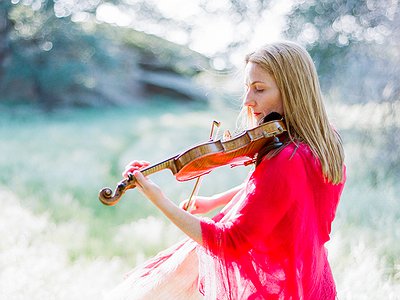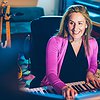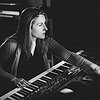What was your first studio like? How and for what reasons has your set-up evolved over the years and what are currently some of the most important pieces of gear for you?
My first studio consisted of a Yamaha DX7II synthesizer that I got in middle school, a nice stereo mobile tape recorder, and a stereo condenser microphone. I was totally obsessed with having my own recording studio from an early age. Around ten years old, I experienced something of a songwriting boom, and I started inhaling issues of Keyboard Magazine. Once a gearhead, always a gearhead!
My current studio is set up so that I can compose, record live instruments, and mix in surround. My main sequencing and mixing platform is Pro Tools HD, with VE Pro servers, and I also take advantage of the UAD system for processing.
Obviously computers, instruments, outboard recording and processing gear, and a long list of software instruments and plugins are key. I also really appreciate my surround monitoring system, which is based around a Grace Design m906 and ATC SCM25As. The Grace is a very high-quality, flexible hub which allows me to switch among all my components, and the ATCs are truly great monitors. I work long hours sometimes, and I find the ATCs are so clear and they don’t fatigue my ears. They translate really well to other environments.
How do you make use of technology? In terms of the feedback mechanism between technology and creativity, what do humans excel at, what do machines excel at?
Broadly speaking, technology is at work even in the most acoustic settings. If I’m writing for or performing on acoustic instruments, the technology consists of the instruments themselves, the notation or musical communication protocols, and the recording equipment. The sonic and musical characteristics of each instrument shape the way an idea materializes through them. As far as electronics and computers, I use these in so many ways: designing sounds with synthesis and processing; developing fully-realized demos with sample libraries; recording and editing; syncing to picture; generating algorithmic score ideas; creating live interactive computer instruments and remix setups; and sharing information with others.
I’ve come to see technology as an extension of embodiment. There is no idea that can exist in our comprehension without material and tools, whatever those tools may be. In today’s environment, artificial intelligence is developing and we’ll see where that leads us. I guess I feel humans excel at humanity and inspiration! Our job is to connect and to bring intuition, insight, vision, and love into the music. Technology shapes our brains, opens us to certain possibilities and closes us to others, speeds certain things up, and slows others down. The key for an artist is to maintain a centered consciousness where we keep asking questions about this relationship, and to choose a path forward from moment to moment that nourishes our creative vitality.
Production tools, from instruments to complex software environments, contribute to the compositional process. How does this manifest itself in your work? Can you describe the co-authorship between yourself and your tools?
My process always involves a feedback network which includes ideation, inner listening, and pre-hearing as well as responsiveness to the concrete sonic and structural options offered by my production toolkit. In an electronic music environment, my sound design work affects my choices of harmonic and temporal structures, and vice-versa, in continual feedback. I love employing pattern generators that include options for randomization or complex variations. I can ask the software to try certain things, and then zoom in on what processes are really getting me the tone and sound that I want. This conversation with software also helps me to refine my understanding of what sound I am seeking for a particular context.
Instruments introduce a co-authoring process for me as well. I’m a violinist, and I play many other instruments including guitars, voice, percussion, keyboards, and so on. When I play and improvise, the musical ideas find different shapes and pathways with each instrument. It’s not just because of what feels natural to play, but it’s also due to the available options for polyphony, timbre, and different kinds of phrasing. Composition also becomes a little more “athletic” when you are playing, and that activates your brain differently. When writing for instruments that I don’t play, the tools are still influencing me, but it’s through my understanding of how they work, and conversations with accomplished players of those instruments, and putting those things through my imagination as I compose.
Collaborations can take on many forms. What role do they play in your approach and what are your preferred ways of engaging with other creatives through, for example, file sharing, jamming or just talking about ideas?
Collaborations are the heart of any scoring endeavor, where you have a group of creative artists coming together to tell a story. In film and tv scoring, many of the collaborations occur across disciplines. My most direct day-to-day interactions are with directors, as well as producers, editors, and in some cases, writers. I like to have good communication with the sound department as well, and it often takes a conscious effort to coordinate the sound and music people on a film. Even though I don’t usually find myself in meetings with actors, cinematographers, production designers, or many of the other creative contributors, I am constantly in conversation with the elements they create– all the colors, tones, pacing, settings, and performances onscreen.
All kinds of collaboration are important: talking about overall themes and aesthetic concepts, watching scenes in progress, performing brief examples of musical ideas, sending music files back and forth. Ultimately, the conversation about score needs to happen in the language of music, and we put music up against picture. There isn’t a substitute for that.
I’ve also recently been working on an audiovisual installation piece with a fellow filmmaker, and that’s been wonderful because we are co-creators, and we’re making choices together about all the aspects of implementation. While we do each have our areas of specialty, it’s kind of a mind-meld, rather than a conventionally differentiated process. We meet in person and share files back and forth as well. We’re also just beginning to write a musical together, and while the compositional aspects of that project will be my job, the conceptualization and writing are very collaborative.
Within musicmaking, of course, there are many important collaborations as well. As a performer, I enjoy the context of improvised music very much because it requires presence, openness, and listening. Playing with other musicians is just the most wonderful and direct way to connect.
Could you take us through a day in your life, from a possible morning routine through to your work? Do you have a fixed schedule? How do music and other aspects of your life feed back into each other - do you separate them or instead try to make them blend seamlessly?
My schedule varies depending on how tight the deadlines are, and how many projects I have going on. These days, if I really need to push hard, I prefer waking up early, like 4am, and getting to bed by 11 instead of staying up until 3am. I always have to be awake by 6am or so, because I have young children. I used to be more of a night owl, but now that I am a parent, I try to keep normal business hours very productive, and that has served me well. It’s important to me to make time for exercise and sleep, and I just do my best to fit it all in. It’s not a perfect process. I don’t compartmentalize, but I do try to create protected, immersive work time where I can go deep with the material and create a lot of music relatively quickly. I always aim to stay open to inspiration and connections in my life. I don’t turn on and off; it’s more about how to modulate and balance different streams. Obviously, schedules and activities need to be delineated, but a lot happens between the lines that contributes to one’s creative process.
Could you describe your creative process on the basis of a soundtrack or album that's particularly dear to you, please? Where did the ideas come from, how were they transformed in your mind, what did you start with and how do you refine these beginnings into the finished work of art?
My film score (and soundtrack album) for the 2012 documentary feature The Skin I’m In is a dear project to me for many reasons. It was my first collaboration with the gifted director Broderick Fox, whom I value very much as a collaborator and friend. It’s a film where I felt welcome to bring original ideas to the conversation. It’s also a film that isn’t very mainstream, one that I feel deserves more attention. It’s primarily an autobiographical story tracing the director’s journey from the brink of death to a profound healing through ritual and art.
After viewing a cut of the film and listening to the temp music, which featured relatively sparse ambiences and instrumentation, I felt strongly that this very intimate story had a bigger emotional range, one that would benefit from a large ensemble. I also was excited by the fact that techno music and the electronic dance scene in Berlin formed a strong throughline in the story. There were brief onscreen vocal performances which I thought could be woven into the texture of the music. When I presented the idea to Broderick of going bigger, and creating a hybrid orchestral-electronic score, to his credit, he kept an open mind. As we worked together in one-on-one meetings to refine each moment, and I created demos of the music, we were able to experience how these languages could merge in a unique way that gives voice to the film. Then, fortunately, Sundance and Time-Warner came through and awarded me their Film Music Fellowship grant. I applied the funding to live orchestral recordings, and in conducting the orchestra, I was able to achieve the level of expressivity that we needed.





